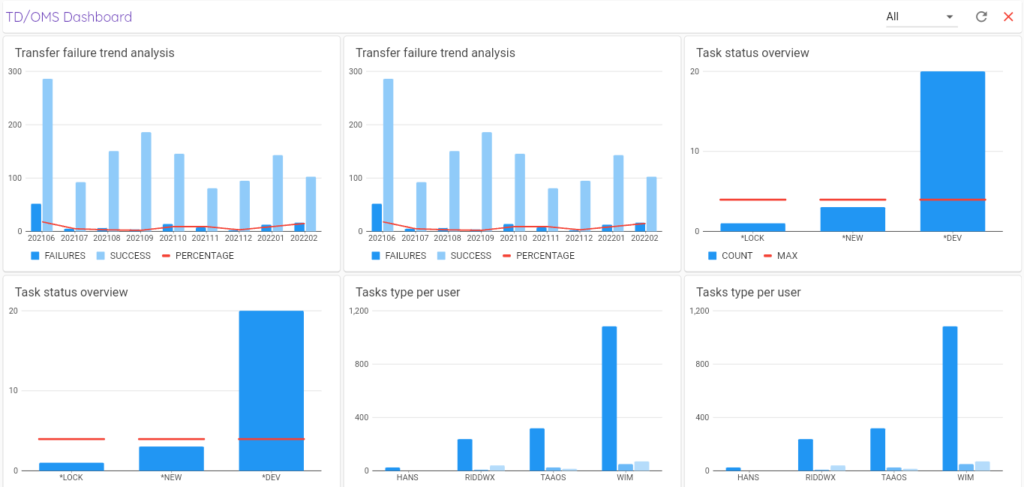We took a step forward on our road to innovation and the result of it is here: Its name is Octo.
Octo stands for “Open Core for Technology Orchestration”. It is a web-based orchestration layer that displays information from our other applications, including TD/OMS, in an organized and visual way.
Octo is the framework that allows us to bind all our applications together. From it, you can access all information from our applications TD/OMS and Gravity.
TD/OMS DASHBOARD
The Octo TD/OMS Dashboard shows analytical information about the state of your TD/OMS server. It will signal warnings like missing source and problematic transfers. It contains trend analysis charts to show how your DevOps is improving over time.
Please read the internal wiki documentation (login required) to find out how to plug in your TD/OMS.


Octo allows you to see all the tasks and requests in TD/OMS.
To configure Octo to work together with your TD/OMS, please follow the instructions on our wiki.
The following features are available:
- Create Task and Request Filters
- Show the Dashbord
- Change basic Information
- Ratify a task or a request
- Deep link your task or request (e.g. from your issue tracking tool)
KANBAN
Octo comes with a Kanban tool that shows tasks and assignments in an organized way, from to-dos, to work in progress, testing, and completed. You can easily move tasks from one column to another, delete them, and sort them at your convenience.
At the moment the Kanban is operating against an internal database. We are going to hook in TD/OMS in milestone 3.

CONTACT US
Get in Touch!

FAQ
What is regression testing?
Regression testing (rarely, non-regression testing) is re-running functional and non-functional tests to ensure that previously developed and tested software still performs as expected after a change. If not, that would be called a regression.
What is end-to-end testing?
End-to-end testing is a software testing methodology that verifies the behavior and functionality of an entire application or system from start to finish. It focuses on testing the flow of data and processes across various components, subsystems, and interfaces, ensuring that the system works as intended and meets the desired requirements. In end-to-end testing, the system is tested as a whole, simulating real-world scenarios and user interactions to validate its functionality, performance, and reliability. It involves testing multiple interconnected modules or components to ensure seamless integration and proper functioning of the complete system.
Why is it often difficult to test an IBM i interactive application with 5250 screens?
Traditional 5250 screens are text-based and lack well-defined user interface elements. This can make it challenging to automate the testing process using conventional UI automation tools. Interacting with 5250 screens often requires emulating terminal input and capturing text-based output, which is automatically provided with our tool.
What is the ROI of testing in a digital transformation project?
The return on investment (ROI) of testing in a digital transformation project can be substantial. While the exact ROI will vary depending on the project and organization, here are several ways testing can contribute to ROI: Early Issue Identification and Cost Reduction: Testing helps identify defects, bugs, or functional gaps early in the development process. By catching and addressing issues early, organizations can avoid costly rework, minimize the impact on downstream processes, and reduce the overall project costs. Improved Customer Experience: Digital transformation projects often aim to enhance the customer experience. Through thorough testing, organizations can ensure that the transformed systems, applications, or interfaces provide a seamless, user-friendly experience. This can result in increased customer satisfaction, loyalty, and potentially higher revenue generation. Reduced Downtime and Business Disruptions: Effective testing minimizes the risk of system failures, downtime, or disruptions during the transformation or after the go-live. By identifying and addressing potential issues in advance, organizations can avoid business interruptions, maintain operational continuity, and prevent revenue loss. Enhanced System Performance and Scalability: Performance testing and load testing activities help identify and address performance bottlenecks, scalability issues, or potential limitations of the transformed system. Ensuring that the system can handle increased workloads or user demands improves overall system performance, user satisfaction, and the organization’s ability to handle growth. Compliance and Risk Mitigation: Digital transformation projects often involve compliance with industry regulations, security standards, and data privacy requirements. Effective testing ensures that the transformed system meets these compliance needs, minimizing the risk of regulatory penalties, reputational damage, or legal issues. Increased Efficiency and Productivity: Thorough testing helps identify areas for process improvement, automation opportunities, or usability enhancements. By streamlining workflows, eliminating manual tasks, and improving system efficiency, organizations can realize productivity gains, cost savings, and improved employee satisfaction. Reduced Maintenance and Support Costs: Proper testing helps identify and rectify issues before the system goes into production. This can lead to a decrease in post-production support and maintenance costs as fewer defects or issues arise, resulting in improved system stability and reduced ongoing support efforts. It’s important to note that the ROI of testing in a digital transformation project is influenced by various factors, such as the project’s scale, complexity, industry, and the effectiveness of the testing processes implemented. Organizations should consider these factors when planning and allocating resources for testing, aiming to maximize the ROI and ensure the successful outcome of the transformation project.


